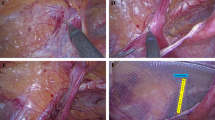Abstract
Purpose
In Japan, transabdominal preperitoneal (TAPP) inguinal hernia repair is performed by firmly pulling the peritoneum inwards to lift it from the underlying deep layer of subperitoneal fascia. It decreases the postoperative pain and discomfort in the inguinal area. The aim of this study was to evaluate the feasibility of the sandwich approach, which is a new technique for creating a preperitoneal space.
Methods
The operation was performed via the sandwich approach. We made sure to protect the preperitoneal fascia areolar layer when making the preperitoneal space.
Results
We performed TAPP in 745 patients (876 hernias) treated between October 2006 and April 2015 at Himeji Medical Center and Kurashiki Central Hospital. Before October 2010, we did not use the sandwich approach, and recurrence was observed in three patients. From October 2010, we always used the sandwich approach and never experienced any cases of recurrence. Clavien–Dindo classification Grade 3 or higher postoperative complications occurred in 6 patients (0.8%) between October 2006 and April 2015. Mesh-related ileus was the most frequently observed morbidity. There were no cases of vas differentia or spermatic vessel injury, postoperative chronic pain, or urinary retention.
Conclusion
The sandwich approach is feasible as another standard dissective procedure for TAPP.





Similar content being viewed by others
References
Simons MP, Aufenacker T, Bay-Nielsen M, Bouillot JL, Campanelli G, Conze J, et al. European Hernia Society guidelines on the treatment of inguinal hernia in adult patients. Hernia. 2009;13:343–403.
Bittner R, Arregui ME, Bisgaard T, Dudai M, Ferzli GS, Fitzgibbons RJ, et al. Guidelines for laparoscopic (TAPP) and endoscopic (TEP) treatment of inguinal hernia [International Endohernia Society (IEHS)]. Surg Endosc. 2011;25:2773–843.
Bittner R, Schmedt CG, Schwarz J, Kraft K, Leibl BJ. Laparoscopic transperitoneal procedure for routine repair of groin hernia. Br J Surg. 2002;89:1062–6.
Fowler R. The applied surgical anatomy of the preperitoneal fascia of the groin and the secondary internal ring. Aust NZ J Surg. 1975;45:8–14.
Sato T, Hashimoto M. Morphological analysis of the fascial lamination of the trunk. Bull Tokyo Med Dent Univ. 1984;31:21–32.
Read CR. Cooper’s posterior lamina of transversalis fascia. Surg Gynecol Obstet. 1992;174:426–34.
Stoppa R, Diarra B, Mertl P. The retroparietal spermatic sheath—an anatomical structure of surgical interest. Henia. 1997;1:55–9.
Retzius AA. Some remarks on the proper design of the semilunar lines of Douglas. Edinb Med J. 1858;3:865–7.
Cooper AP. The anatomy and surgical treatment of inguinal and congenital hernia. London: Longman; 1804.
Mirilas P, Mentessidou A, Skandalakis JE. Secondary internal inguinal ring and associated surgical planes: surgical anatomy, embryology, applications. J Am Coll Surg. 2008;206(3):561–70.
Arregui ME. Surgical anatomy of the preperitoneal fasciae and posterior transversalis fasciae in the inguinal region. Hernia. 1997;1:101–10.
Suwa K, Nakajima S, Hanyu K, Suzuki T, Okamoto T, Yanaga K. Modified Kugel herniorrhaphy using standardized dissection technique of the preperitoneal space: long-term operative outcome in consecutive 340 patients with inguinal hernia. Hernia. 2013;17(6):699–707.
Katayama H, Kurokawa Y, Nakamura K, Ito H, Kanemitsu K, Masuda N, et al. Extended Clavien–Dindo classification of surgical complications: Japan Clinical Oncology Group postoperative complications criteria. Surg Today. 2016;46:668–85.
Peitsch WK. A modified laparoscopic hernioplasty (TAPP) is the standard procedure for inguinal and femoral hernias: a retrospective 17-years analysis with 123 hernia repairs. Surg Endosc. 2013 (Epub ahead of print).
Bracale U, Melillo P, Pignata G, Di Salvo E, Rovani M, Merola G, et al. Which is the best laparoscopic approach for inguinal hernia repair: TEP or TAPP. A systematic review of the literature with a net work meta-analysis? Surg Endosc. 2013;27:4702–10.
Fitzgibbons RJ Jr, Puri V. Laparoscopic inguinal hernia repair. Am Surg. 2006;72:197–206.
Author information
Authors and Affiliations
Corresponding author
Ethics declarations
Conflict of interest
NY, HS, CK, SR, HN, KY, HK, OM, and IT declare that they have no conflicts of interest.
Rights and permissions
About this article
Cite this article
Nagahisa, Y., Homma, S., Chen, K. et al. Feasibility of a new approach for creating a preperitoneal space in transabdominal preperitoneal repair inguinal hernia repair: using a sandwich approach. Surg Today 47, 595–600 (2017). https://doi.org/10.1007/s00595-016-1435-0
Received:
Accepted:
Published:
Issue Date:
DOI: https://doi.org/10.1007/s00595-016-1435-0




